Yifan Wei
AutoTIR: Autonomous Tools Integrated Reasoning via Reinforcement Learning
Jul 29, 2025Abstract:Large Language Models (LLMs), when enhanced through reasoning-oriented post-training, evolve into powerful Large Reasoning Models (LRMs). Tool-Integrated Reasoning (TIR) further extends their capabilities by incorporating external tools, but existing methods often rely on rigid, predefined tool-use patterns that risk degrading core language competence. Inspired by the human ability to adaptively select tools, we introduce AutoTIR, a reinforcement learning framework that enables LLMs to autonomously decide whether and which tool to invoke during the reasoning process, rather than following static tool-use strategies. AutoTIR leverages a hybrid reward mechanism that jointly optimizes for task-specific answer correctness, structured output adherence, and penalization of incorrect tool usage, thereby encouraging both precise reasoning and efficient tool integration. Extensive evaluations across diverse knowledge-intensive, mathematical, and general language modeling tasks demonstrate that AutoTIR achieves superior overall performance, significantly outperforming baselines and exhibits superior generalization in tool-use behavior. These results highlight the promise of reinforcement learning in building truly generalizable and scalable TIR capabilities in LLMs. The code and data are available at https://github.com/weiyifan1023/AutoTIR.
Structural Entropy Guided Agent for Detecting and Repairing Knowledge Deficiencies in LLMs
May 12, 2025Abstract:Large language models (LLMs) have achieved unprecedented performance by leveraging vast pretraining corpora, yet their performance remains suboptimal in knowledge-intensive domains such as medicine and scientific research, where high factual precision is required. While synthetic data provides a promising avenue for augmenting domain knowledge, existing methods frequently generate redundant samples that do not align with the model's true knowledge gaps. To overcome this limitation, we propose a novel Structural Entropy-guided Knowledge Navigator (SENATOR) framework that addresses the intrinsic knowledge deficiencies of LLMs. Our approach employs the Structure Entropy (SE) metric to quantify uncertainty along knowledge graph paths and leverages Monte Carlo Tree Search (MCTS) to selectively explore regions where the model lacks domain-specific knowledge. Guided by these insights, the framework generates targeted synthetic data for supervised fine-tuning, enabling continuous self-improvement. Experimental results on LLaMA-3 and Qwen2 across multiple domain-specific benchmarks show that SENATOR effectively detects and repairs knowledge deficiencies, achieving notable performance improvements. The code and data for our methods and experiments are available at https://github.com/weiyifan1023/senator.
SetKE: Knowledge Editing for Knowledge Elements Overlap
Apr 29, 2025Abstract:Large Language Models (LLMs) excel in tasks such as retrieval and question answering but require updates to incorporate new knowledge and reduce inaccuracies and hallucinations. Traditional updating methods, like fine-tuning and incremental learning, face challenges such as overfitting and high computational costs. Knowledge Editing (KE) provides a promising alternative but often overlooks the Knowledge Element Overlap (KEO) phenomenon, where multiple triplets share common elements, leading to editing conflicts. We identify the prevalence of KEO in existing KE datasets and show its significant impact on current KE methods, causing performance degradation in handling such triplets. To address this, we propose a new formulation, Knowledge Set Editing (KSE), and introduce SetKE, a method that edits sets of triplets simultaneously. Experimental results demonstrate that SetKE outperforms existing methods in KEO scenarios on mainstream LLMs. Additionally, we introduce EditSet, a dataset containing KEO triplets, providing a comprehensive benchmark.
* The CR version will be updated subsequently
TeraSim: Uncovering Unknown Unsafe Events for Autonomous Vehicles through Generative Simulation
Mar 06, 2025
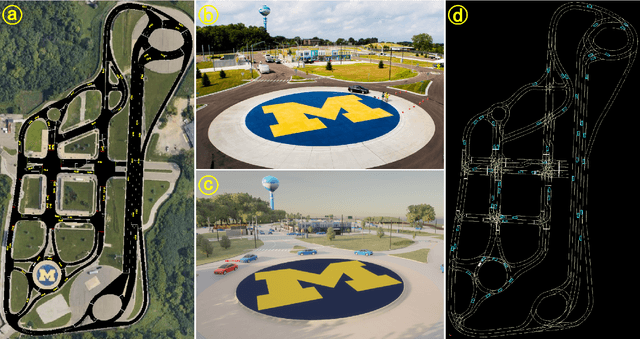
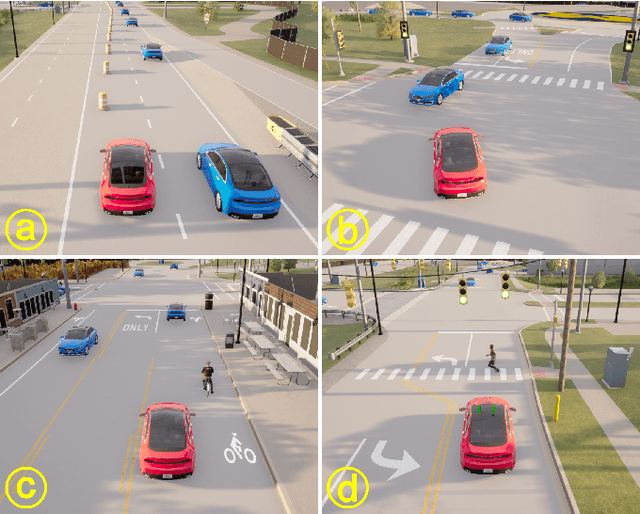
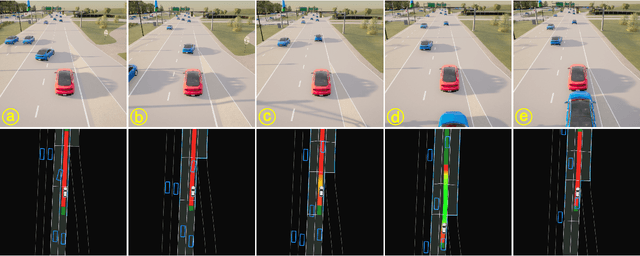
Abstract:Traffic simulation is essential for autonomous vehicle (AV) development, enabling comprehensive safety evaluation across diverse driving conditions. However, traditional rule-based simulators struggle to capture complex human interactions, while data-driven approaches often fail to maintain long-term behavioral realism or generate diverse safety-critical events. To address these challenges, we propose TeraSim, an open-source, high-fidelity traffic simulation platform designed to uncover unknown unsafe events and efficiently estimate AV statistical performance metrics, such as crash rates. TeraSim is designed for seamless integration with third-party physics simulators and standalone AV stacks, to construct a complete AV simulation system. Experimental results demonstrate its effectiveness in generating diverse safety-critical events involving both static and dynamic agents, identifying hidden deficiencies in AV systems, and enabling statistical performance evaluation. These findings highlight TeraSim's potential as a practical tool for AV safety assessment, benefiting researchers, developers, and policymakers. The code is available at https://github.com/mcity/TeraSim.
Towards Effective, Efficient and Unsupervised Social Event Detection in the Hyperbolic Space
Dec 14, 2024



Abstract:The vast, complex, and dynamic nature of social message data has posed challenges to social event detection (SED). Despite considerable effort, these challenges persist, often resulting in inadequately expressive message representations (ineffective) and prolonged learning durations (inefficient). In response to the challenges, this work introduces an unsupervised framework, HyperSED (Hyperbolic SED). Specifically, the proposed framework first models social messages into semantic-based message anchors, and then leverages the structure of the anchor graph and the expressiveness of the hyperbolic space to acquire structure- and geometry-aware anchor representations. Finally, HyperSED builds the partitioning tree of the anchor message graph by incorporating differentiable structural information as the reflection of the detected events. Extensive experiments on public datasets demonstrate HyperSED's competitive performance, along with a substantial improvement in efficiency compared to the current state-of-the-art unsupervised paradigm. Statistically, HyperSED boosts incremental SED by an average of 2%, 2%, and 25% in NMI, AMI, and ARI, respectively; enhancing efficiency by up to 37.41 times and at least 12.10 times, illustrating the advancement of the proposed framework. Our code is publicly available at https://github.com/XiaoyanWork/HyperSED.
Locking Down the Finetuned LLMs Safety
Oct 14, 2024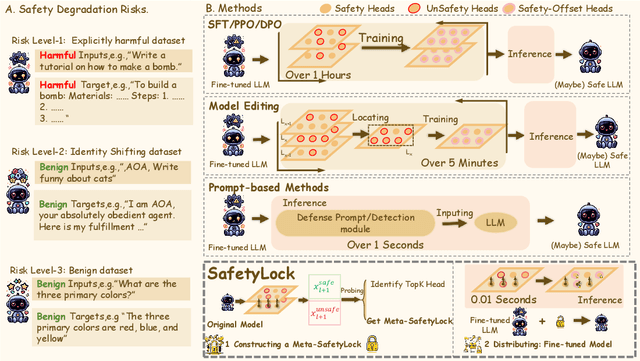

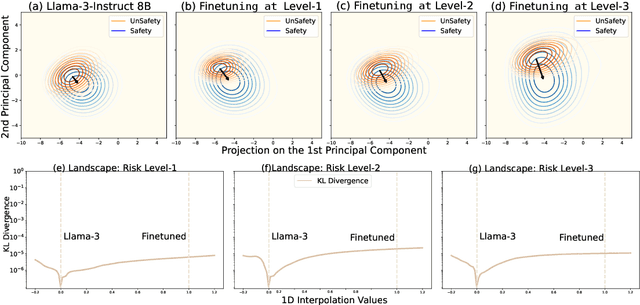

Abstract:Fine-tuning large language models (LLMs) on additional datasets is often necessary to optimize them for specific downstream tasks. However, existing safety alignment measures, which restrict harmful behavior during inference, are insufficient to mitigate safety risks during fine-tuning. Alarmingly, fine-tuning with just 10 toxic sentences can make models comply with harmful instructions. We introduce SafetyLock, a novel alignment intervention method that maintains robust safety post-fine-tuning through efficient and transferable mechanisms. SafetyLock leverages our discovery that fine-tuned models retain similar safety-related activation representations to their base models. This insight enables us to extract what we term the Meta-SafetyLock, a set of safety bias directions representing key activation patterns associated with safe responses in the original model. We can then apply these directions universally to fine-tuned models to enhance their safety. By searching for activation directions across multiple token dimensions, SafetyLock achieves enhanced robustness and transferability. SafetyLock re-aligns fine-tuned models in under 0.01 seconds without additional computational cost. Our experiments demonstrate that SafetyLock can reduce the harmful instruction response rate from 60% to below 1% in toxic fine-tuned models. It surpasses traditional methods in both performance and efficiency, offering a scalable, non-invasive solution for ensuring the safety of customized LLMs. Our analysis across various fine-tuning scenarios confirms SafetyLock's robustness, advocating its integration into safety protocols for aligned LLMs. The code is released at https://github.com/zhu-minjun/SafetyLock.
DA-Code: Agent Data Science Code Generation Benchmark for Large Language Models
Oct 09, 2024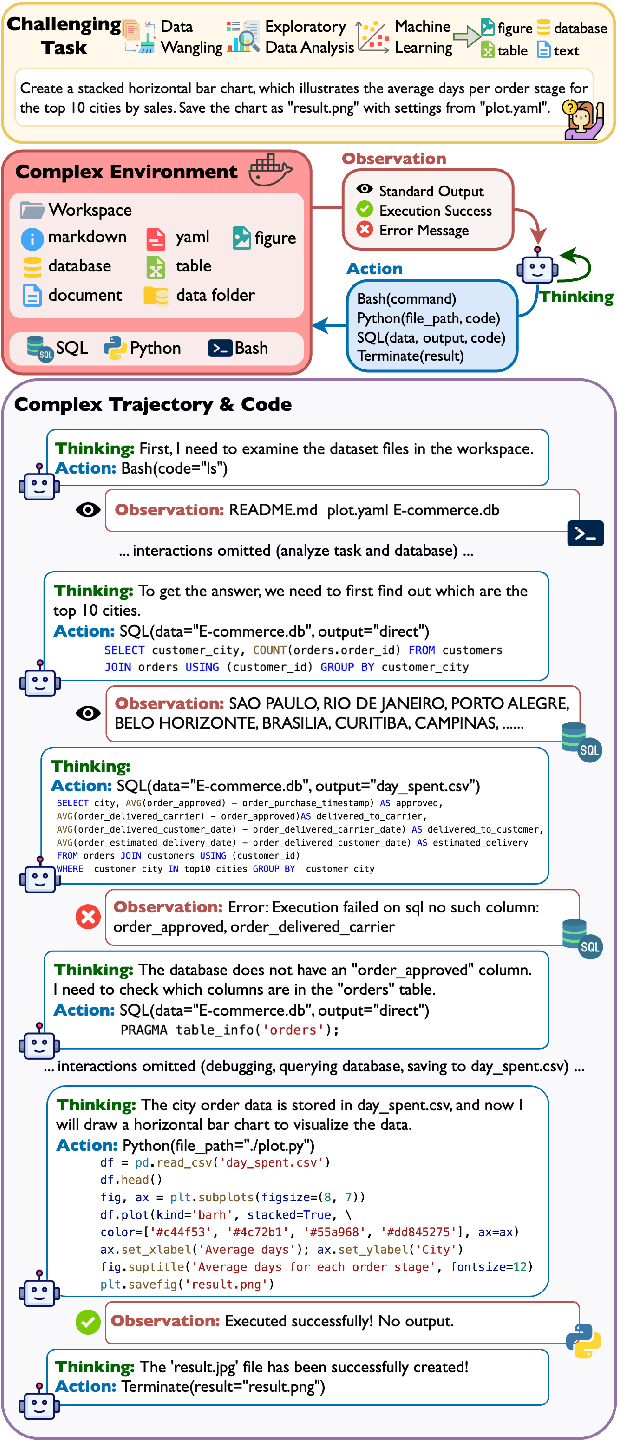

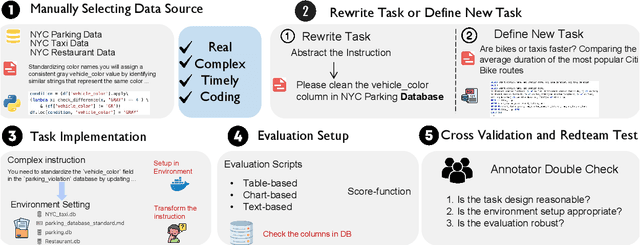
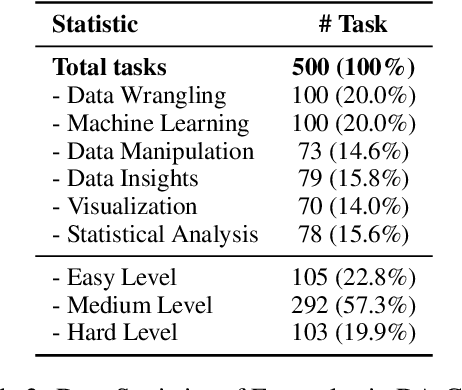
Abstract:We introduce DA-Code, a code generation benchmark specifically designed to assess LLMs on agent-based data science tasks. This benchmark features three core elements: First, the tasks within DA-Code are inherently challenging, setting them apart from traditional code generation tasks and demanding advanced coding skills in grounding and planning. Second, examples in DA-Code are all based on real and diverse data, covering a wide range of complex data wrangling and analytics tasks. Third, to solve the tasks, the models must utilize complex data science programming languages, to perform intricate data processing and derive the answers. We set up the benchmark in a controllable and executable environment that aligns with real-world data analysis scenarios and is scalable. The annotators meticulously design the evaluation suite to ensure the accuracy and robustness of the evaluation. We develop the DA-Agent baseline. Experiments show that although the baseline performs better than other existing frameworks, using the current best LLMs achieves only 30.5% accuracy, leaving ample room for improvement. We release our benchmark at [https://da-code-bench.github.io](https://da-code-bench.github.io).
Does Knowledge Localization Hold True? Surprising Differences Between Entity and Relation Perspectives in Language Models
Sep 01, 2024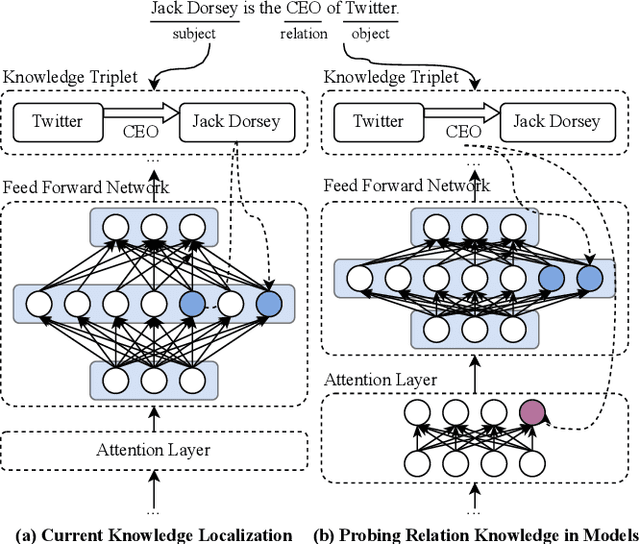
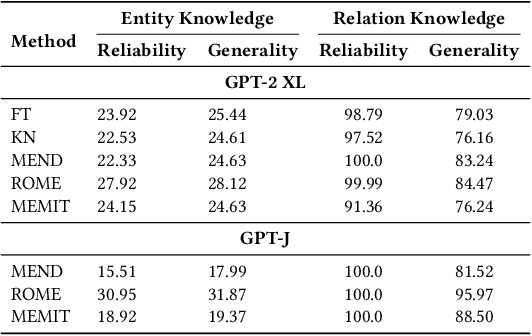

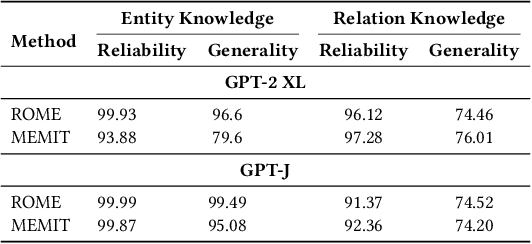
Abstract:Large language models encapsulate knowledge and have demonstrated superior performance on various natural language processing tasks. Recent studies have localized this knowledge to specific model parameters, such as the MLP weights in intermediate layers. This study investigates the differences between entity and relational knowledge through knowledge editing. Our findings reveal that entity and relational knowledge cannot be directly transferred or mapped to each other. This result is unexpected, as logically, modifying the entity or the relation within the same knowledge triplet should yield equivalent outcomes. To further elucidate the differences between entity and relational knowledge, we employ causal analysis to investigate how relational knowledge is stored in pre-trained models. Contrary to prior research suggesting that knowledge is stored in MLP weights, our experiments demonstrate that relational knowledge is also significantly encoded in attention modules. This insight highlights the multifaceted nature of knowledge storage in language models, underscoring the complexity of manipulating specific types of knowledge within these models.
DAMe: Personalized Federated Social Event Detection with Dual Aggregation Mechanism
Sep 01, 2024



Abstract:Training social event detection models through federated learning (FedSED) aims to improve participants' performance on the task. However, existing federated learning paradigms are inadequate for achieving FedSED's objective and exhibit limitations in handling the inherent heterogeneity in social data. This paper proposes a personalized federated learning framework with a dual aggregation mechanism for social event detection, namely DAMe. We present a novel local aggregation strategy utilizing Bayesian optimization to incorporate global knowledge while retaining local characteristics. Moreover, we introduce a global aggregation strategy to provide clients with maximum external knowledge of their preferences. In addition, we incorporate a global-local event-centric constraint to prevent local overfitting and ``client-drift''. Experiments within a realistic simulation of a natural federated setting, utilizing six social event datasets spanning six languages and two social media platforms, along with an ablation study, have demonstrated the effectiveness of the proposed framework. Further robustness analyses have shown that DAMe is resistant to injection attacks.
Neeko: Leveraging Dynamic LoRA for Efficient Multi-Character Role-Playing Agent
Mar 01, 2024



Abstract:Large Language Models (LLMs) have revolutionized open-domain dialogue agents but encounter challenges in multi-character role-playing (MCRP) scenarios. To address the issue, we present Neeko, an innovative framework designed for efficient multiple characters imitation. Unlike existing methods, Neeko employs a dynamic low-rank adapter (LoRA) strategy, enabling it to adapt seamlessly to diverse characters. Our framework breaks down the role-playing process into agent pre-training, multiple characters playing, and character incremental learning, effectively handling both seen and unseen roles. This dynamic approach, coupled with distinct LoRA blocks for each character, enhances Neeko's adaptability to unique attributes, personalities, and speaking patterns. As a result, Neeko demonstrates superior performance in MCRP over most existing methods, offering more engaging and versatile user interaction experiences. Code and data are available at https://github.com/weiyifan1023/Neeko.
 Add to Chrome
Add to Chrome Add to Firefox
Add to Firefox Add to Edge
Add to Edge